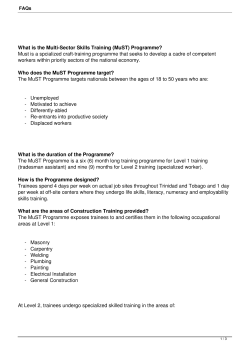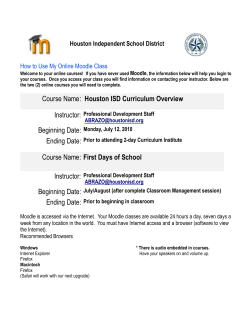
Title How to deploy a Blended learning offer
Grundtvig Project TALIS – “Trainers in adult learning - innovative strategies” GRU-11-P-LP-6-B-IT (ID NATIONAL) 2011-1-IT2-GRU06-23549 2 (ID PROJECT) Title How to deploy a Blended learning offer February, 2013 References Donato De Silvestri Ubaldo Pernigo Project ID GRU-11-P-LP-6-B-IT (ID NATIONAL) 2011-1-IT2-GRU06-23549 2 (ID PROJECT) Document Version 4.0 IT.Bosco.UPDDS.February.2013 Status Released version Istituto Comprensivo Bosco Chiesanuova P.tta degli Alpini, 5 – 37021 Bosco Chiesanuova Tel. 045.6780521 – 045.6782042 Fax 045.7050012 E-mail u.r.p.: segreteria@istitutobosco.it Dirigente Scolastico: dirigente@istitutobosco.it Web: www.istitutobosco.it 1 Introduction Blended Learning is a recurring topic in educational and training systems. Blended Learning approach refers to the possibility of conducting a training action that can benefit of both the characteristics of its educational in presence mode (classroom lectures, work group), and of those on the net (discussions, assisted remote tutorials, collaborative design, on line e-learning). In Blended Learning the environment in not confined on line but it is related also with in presence opportunity and with all possible educational strategies activated within them. Aside from the approach the common goal is to shift the locus of control from the teacher to the learner. The design and implementation of high quality blended courses, no depend on the subject, require a wide approach and involve a team group work. Teachers and people involved in the organization of blended courses have to develop contents for in presence and for on line activities, have assist technical expertise to deploy the on line side and must keep in touch with trainees. All modules and related documents should be provided in electronic format. Teachers must have regular feedback, they must be on line and promote opportunities to learn from each other collaboratively in their virtual classes. Access must be 24/7 to all on line learning content, and trainees must have control on their progress, have to receive supporting feedback on this progress, and staffs has to take care of student progress and provide feedback quickly to each learner. Design, implementation and management The design, implementation and management of Blended Learning environment is not costless and is important to have a look at the future and create a long-term sustainable model. In designing a blended course it is necessary beforehand to locate a digital learning environment to be used in the activities to be performed on-line by the participants of the course. The platform should be aligned to the common on line e-learning standards. The open source Moodle platform is widely used but there are other possibilities, open and free of charge, as the possibility to hire a professional service to deliver courses to trainees. 2 Teachers involved have to be able to produce and to edit course contents and course settings. The blended learning course should be designed to empower educators to effectively teach in online learning environments and differentiate instruction in ways that would be difficult to do in traditional learning environments. The online environment, supported by an e-tutor, is the place where there is the acquisition of knowledge, the development of individual and group activities, where best practices on a large scale and materials are shared, where the student participates in virtual classroom and in a wider community. Planning a Blended model requires also to balance in presence classroom with on line activities ant to avoid poor integration of these two aspects. It is fundamental to plan which activities have to be carried out in blended and which have to be carried out off-line. There is no classical teacher in Blended environment but the e-tutor/tutor is a facilitator, his work does not end in the classroom, but takes place in continuity in the virtual classroom. The e-tutor is an on line presence, a secure point and for support, He is the person who knows the trainers path and progress. The classroom is the place where indispensable support to the online processes and orientation to the customization of the training occurs. In the beginning trainees need to be introduced to the on line environment and to have support for technological skills needed to use the online environment. It is during in presence classroom that the e-tutor discusses issues of common interest and training issues, sharing the output of individual activities carried out online. Community and peer to peer support is an opportunity of cultural growth in the virtual classroom and the e-tutor has to promote it. A group of people who perform the same objectives can meet in a virtual classroom, discuss, synchronous and asynchronous, and share and increase their knowledge. 3 Choosing a platform All platforms used to deliver Blended courses have several features considered typical of an e-learning platform. There are commercial vendors for corporate and education applications for Learning Management System (LMS) and Virtual Learning Environment (VLE). In addition to commercial packages, many open source solutions are available. Moodle (Modular Object-Oriented Dynamic Learning Environment) i.e. is a free source elearning software platform, also known as a Learning Management System, or Virtual Learning Environment. (moodle.org) Moodle platform is very similar to a learning management system and can be used in many types of environments such as in education, training and development, and business settings. Developers can extend Moodle's modular construction by creating plugins for specific new functionality. Moodle's infrastructure supports many types of plugins. Aside from the platform you chose, interoperability in a must. On line instruments and contents All platforms have some typical features. • • • • • • • • • • Assignment submission Discussion forum Blog Wiki Instant messages system Upload and download files Grading Online calendar Online news and announcement Online quiz and test systems Before you start it is important to choose the features to be used in a specific virtual classroom. Too many features disorient the user. 4 Availability of contents is also a critical point on delivering Blended and e-learning offer. Developing and building high-quality e-learning content requires a great deal of time and energy. Standard (i.e. SCORM specification), reusability and compatibility with Learning Management System are also to be considered. There are also content repositories of Learning Object, open and free (i.e. the SLOOP project - Sharing Learning Objects in an Open Perspective). www.sloopproject.eu In this paper we assume that contents are available, developed and organized in a repository ready to deliver courses. Deploy a typical blended service When contents and platform are ready for working, the Blended Courses are to be scheduled. In presence and on line phases must be planned according to on the type of courses and objectives. Before you start Every e-tutor must obtain from the tutor panel the list of trainees, plan a date for the kick-off meeting and send a welcome message to all participants, also checking their e-mail. In some experience it was very useful to have a profile of all participants (ITC skills, self-assessment of needs and expectations, address and phone numbers). The results are used to prepare targets for the training agreement. The e-tutor sets the virtual classroom with an opening message of activities, prepares discussion and shares folders (i.e. a folder to collect the questionnaires and provided initial training, ...). 5 Introductory session All courses must start with an introductory in presence session. The classroom is formed and the general structure of the entire training program will be presented. The e-tutor explains the objectives, the content of the entire course, the functions and capabilities of e-learning methodology, the platform services and tutoring. A "Training agreement " (contratto formativo) will usually be established between e-tutor and trainees, laying the groundwork for the emergence of the learning community. In this session the e-tutor presents the online environment and how to access. All trainees must have access to the environment and e-tutor has to evaluate case that has not all technological skills needed. If necessary, it will be followed by one or more in presence sessions. Accompanying phase and on line activities The virtual classroom starts as a learning community. The e-tutor helps the trainees, for the entire duration of the course, to solve any technical and learning problems related to the platform. During this phase a key role is played by the e-tutor. Learners must be supported in the organization of the course, in the choice of the content on the platform according to their needs, experience and expertise level, motivation and participation should be promoted. The e-tutor has to monitor "the classroom climate" based on feedback from learners, using synchronous and asynchronous communication, providing answers in a reasonable timescale, invite to share experiences, problems and doubts within the virtual classroom, using the discussion forum. In order to support the learning process, it is important to provide the course/platform with different types of assessment. • • • Moments of self-assessment through tutorials and interactive tests to be carried out during in class and online activity. Test for self-learning at the end of the module. Test course for assessment, to provide, even by independent assessors, a "measure" of student learning. 6 Intermediate session An intermediate session could be planned. There is a return to the classroom to evaluate problems trainees may have encounter during the on line activities and to stimulate the trainees to focus on one or more possible learning activities that could be developed. Final session A finale session has the aim to systematize the knowledge, retracing the main contents of the course, create an opportunity for discussion with the e-tutor and deepen the implications of what the students have learned, in their working environment. Sample timetable ANSAS - Puntoedu IWB in Italy: the Piano Nazionale di diffusione delle LIM 2011-12 7 8
© Copyright 2025














